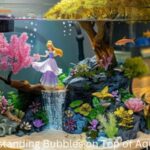How to Lower Water Hardness in an Aquarium? Water hardness is a critical parameter in maintaining a healthy aquarium environment. Understanding and controlling water hardness is essential for the well-being of your aquatic life. This article Guide to Fish Raising will delve into what water hardness is, why it matters, and various methods to lower water hardness in an aquarium effectively.
Table of contents
ToggleUnderstanding Water Hardness
What is Water Hardness?
Water hardness is a measure of the concentration of dissolved minerals, primarily calcium and magnesium, in the water. It is expressed in degrees of hardness (dH) or parts per million (ppm). There are two types of water hardness:
- General Hardness (GH): Measures the total concentration of calcium and magnesium ions.
- Carbonate Hardness (KH): Measures the concentration of carbonate and bicarbonate ions, which influence the water’s buffering capacity and pH stability.
Why Water Hardness Matters?
Water hardness affects the health and behavior of fish and plants. Some species thrive in hard water, while others prefer soft water. Incorrect water hardness can lead to stress, disease, and even death for sensitive species. It also influences water chemistry, including pH levels and the solubility of various nutrients and compounds.
How to Lower Water Hardness in an Aquarium? Methods to Lower Water Hardness
Using Reverse Osmosis (RO) Water
Reverse Osmosis System: One of the most effective ways to lower water hardness is by using a reverse osmosis (RO) system. This filtration method removes nearly all dissolved minerals, producing soft water with minimal GH and KH levels.
Installation and Maintenance:
- Installation: Set up the RO unit according to the manufacturer’s instructions. It typically involves connecting the system to a water source and a storage tank.
- Maintenance: Regularly replace filters and membranes to ensure the system functions efficiently. Monitor water quality to detect any changes in performance.
Mixing with Tap Water:
- Mixing Ratios: Combine RO water with tap water to achieve the desired hardness. Test the hardness after mixing to ensure it meets the needs of your aquarium inhabitants.
Peat Moss
Peat Moss in Filtration:
- Filter Media: Place peat moss in your filter to naturally soften water. Peat releases tannic and humic acids, which bind to calcium and magnesium ions, reducing hardness.
- Preparation: Soak peat moss in water before use to prevent excessive staining. Replace peat moss regularly as it loses effectiveness over time.
Creating a Peat Moss Bag:
- DIY Method: Place peat moss in a mesh bag and submerge it in the aquarium or filter. Monitor water hardness and pH levels, as peat can lower pH significantly.
Driftwood
Natural Water Softening:
- Aquarium Decor: Adding driftwood to your aquarium can help lower water hardness. As driftwood decomposes, it releases acids that soften the water.
- Selection: Choose aquarium-safe driftwood to avoid introducing harmful substances. Boil or soak driftwood before use to remove tannins and prevent excessive staining.
Indian Almond Leaves
Beneficial Properties:
- Tannins and Acids: Indian almond leaves release tannins and humic acids into the water, reducing hardness and providing additional benefits such as antimicrobial properties.
- Usage: Place a few leaves in the aquarium, replacing them as they decompose. Monitor water parameters regularly.
Water Softening Pillows
Commercial Solutions:
- Product Description: Water softening pillows are commercially available products designed to reduce water hardness. They contain ion exchange resins that bind to calcium and magnesium ions.
- Usage: Follow the manufacturer’s instructions for placement and replacement. Monitor water hardness to ensure effectiveness.
Distilled Water
Supplemental Water Source:
- Water Changes: Use distilled water for partial water changes to gradually lower hardness. Distilled water lacks minerals, making it soft.
- Mixing: Combine distilled water with tap water to maintain stability and avoid drastic changes in water chemistry.
Rainwater
Natural Soft Water:
- Collection: Collect rainwater in a clean, chemical-free container. Test the water for contaminants before use.
- Mixing: Use rainwater for partial water changes, mixing it with tap water to achieve desired hardness levels.
Chemical Treatments
Commercial Products:
- Water Conditioners: Various commercial water conditioners can reduce hardness. These products often contain chelating agents that bind to calcium and magnesium ions.
- Usage: Follow the manufacturer’s instructions for dosing and application. Monitor water parameters closely.
Step-by-Step Guide to Lowering Water Hardness

Maintaining optimal water hardness is crucial for the health and well-being of your aquarium inhabitants. Follow this detailed step-by-step guide to effectively lower water hardness in your aquarium.
Step 1: Test Your Water
Testing Kits:
- Importance: Accurate testing of General Hardness (GH) and Carbonate Hardness (KH) levels is essential to understand your starting point and to monitor changes.
- Choosing a Kit: Use reliable, high-quality testing kits from reputable brands. Liquid test kits are generally more accurate than test strips.
- How to Test:
- Sample Collection: Collect a water sample from your aquarium using a clean container.
- Testing Procedure: Follow the instructions on the testing kit carefully. Typically, you will add a specified number of drops of a reagent to a water sample and observe the color change.
- Reading Results: Compare the color of the sample with the provided chart to determine GH and KH levels. Record these values for future reference.
Recording Initial Values:
- Documentation: Maintain a logbook or digital record of the initial GH and KH levels. This helps track the effectiveness of the methods you implement and provides a reference for future adjustments.
Step 2: Choose a Method
Consider Inhabitants:
- Species Requirements: Research the preferred water hardness levels for your fish and plants. Some species are sensitive to changes in hardness and require specific conditions.
- Soft Water Species: Examples include Discus, Tetras, and certain types of Catfish.
- Hard Water Species: Examples include African Cichlids and Livebearers like Guppies and Mollies.
- Plant Preferences: Some aquatic plants also prefer softer water, while others can tolerate a wider range of hardness levels.
Method Selection:
- Natural Methods: Consider methods such as using peat moss, driftwood, or Indian almond leaves, which are gentle and beneficial for creating a natural environment.
- Mechanical Methods: For more control and efficiency, use reverse osmosis (RO) systems, water softening pillows, or distilled water.
- Chemical Treatments: As a last resort, use commercial water conditioners specifically designed to lower hardness. These should be used with caution and precise dosing.
Step 3: Implement the Method
Gradual Changes:
- Avoid Shocks: Implement changes slowly to avoid shocking your aquatic life. Rapid changes in water chemistry can cause stress and health issues.
- Monitoring: During the implementation phase, monitor water parameters closely. Check GH and KH levels daily or every other day to observe the effects of the chosen method.
Detailed Implementation:
- Reverse Osmosis (RO) Water:
- Setup: Install the RO system according to the manufacturer’s instructions.
- Mixing: Gradually mix RO water with your aquarium water. Start with a 10-20% water change using RO water and increase gradually.
- Peat Moss:
- Preparation: Rinse peat moss thoroughly before use to remove dust and prevent excessive staining.
- Placement: Place the peat moss in a filter bag and position it in the filter or directly in the aquarium.
- Monitoring: Check the color of the water and GH/KH levels regularly.
- Driftwood:
- Selection: Choose aquarium-safe driftwood and prepare it by boiling or soaking to remove tannins.
- Placement: Add the driftwood to the aquarium and monitor the water hardness over time.
- Indian Almond Leaves:
- Usage: Add a few leaves to the aquarium. Replace them as they decompose.
- Monitoring: Keep an eye on water color and hardness levels.
- Water Softening Pillows:
- Placement: Place the pillows in the filter or directly in the water flow.
- Replacement: Replace them as directed by the manufacturer.
Step 4: Monitor and Adjust
Regular Testing:
- Frequency: Test GH and KH levels regularly, at least once a week during the adjustment period.
- Observations: Note any significant changes in water hardness and pH levels. Ensure that changes are gradual and within safe ranges for your aquarium inhabitants.
Adjustments:
- Method Adjustment: If the chosen method is not achieving the desired results, adjust the dosage or frequency. For example, if using peat moss, you may need to increase the amount or replace it more frequently.
- Combining Methods: In some cases, combining multiple methods (e.g., using both peat moss and RO water) can provide better results. Ensure compatibility and monitor closely.
Step 5: Maintain Stability
Consistent Practices:
- Routine Maintenance: Continue regular water changes and maintenance practices. Consistency is key to maintaining stable water conditions.
- Filter Maintenance: Clean and replace filter media as needed, especially if using methods like peat moss that can clog filters over time.
Avoid Drastic Changes:
- Gradual Adjustments: Always make adjustments gradually to avoid stressing your aquatic life.
- Long-Term Monitoring: Even after achieving the desired hardness levels, continue to monitor GH and KH regularly to detect any fluctuations.
Additional Tips:
- Documentation: Keep detailed records of all changes, including dates, methods used, and test results. This helps in understanding the long-term effects and making informed decisions.
- Emergency Preparedness: Have a contingency plan for dealing with unexpected changes in water hardness or system failures. Keep spare equipment and necessary supplies on hand.
- Consultation: If you are unsure about any aspect of lowering water hardness or if you encounter persistent issues, seek advice from experienced aquarists or professionals.
Special Considerations
Fish and Plant Preferences
- Species Requirements: Research the specific water hardness preferences of your fish and plants. Tailor your approach to meet their needs and ensure their well-being.
- Mixed Inhabitants: If you have a mixed aquarium with species that have different hardness preferences, aim for a middle ground that accommodates most inhabitants.
pH Stability
- Buffering Capacity: Lowering KH can affect the water’s buffering capacity, leading to pH fluctuations. Monitor pH levels closely and adjust as needed to maintain stability.
- pH Adjustments: If pH drops significantly, consider using buffers or pH stabilizers to maintain a safe and stable environment.
Water Source Quality
- Tap Water Variability: Tap water quality can vary over time. Regularly test your water source to detect any changes that might affect your aquarium’s water hardness.
- Alternative Sources: Consider using alternative water sources like RO water, distilled water, or rainwater to maintain consistent hardness levels.
Maintenance Routine
- Regular Cleaning: Keep your aquarium clean by performing regular water changes, cleaning filters, and removing debris. A clean environment supports stable water chemistry.
- Filter Maintenance: Ensure your filter media, especially if using peat moss or other softening agents, is maintained and replaced as needed.
Conclusion
Lowering water hardness in an aquarium requires careful planning, implementation, and monitoring. By understanding the needs of your aquatic life and choosing the appropriate methods, you can create a stable and healthy environment. Regular testing, gradual adjustments, and consistent maintenance are key to successfully managing water hardness and ensuring the well-being of your fish and plants.
Whether you opt for natural methods like peat moss and driftwood or utilize advanced systems like reverse osmosis, maintaining optimal water hardness levels will contribute to a thriving aquarium. Remember to stay informed, be patient, and always prioritize the health of your aquatic inhabitants.





